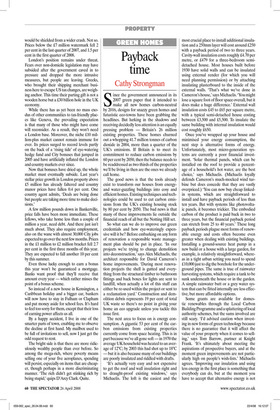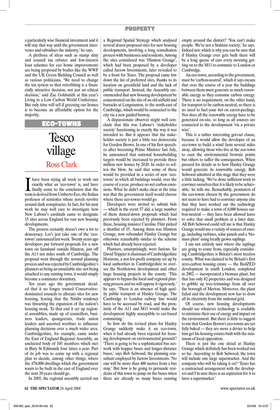Payback time
Cathy Strongman
Since the government announced in its 2007 green paper that it intended to make all new homes carbon-neutral by 2016, designs for snazzy green homes and futuristic eco-towns have been grabbing the headlines. But lurking in the shadows and receiving decidedly less attention is an equally pressing problem — Britain’s 26 million existing properties. These homes churned out a whopping 41.7 million tonnes of carbon dioxide in 2004, more than a quarter of the UK’s emissions. If Britain is to meet its commitment to reduce carbon emissions by 60 per cent by 2050, then the balance needs to be readdressed as two thirds of the properties we’ll be living in then are the ones we already call home.
The good news is that the tools already exist to transform our houses from energyand water-guzzling buildings into cosy and efficient homes. Existing techniques and technologies could be used to cut carbon emissions from the UK’s existing housing stock by 80 per cent by 2050. The bad news is that many of these improvements lie outside the financial reach of all but the Notting Hill set.
So what can we do to improve our green credentials and how eye-wateringly expensive will it be? Before embarking on any form of renovation a responsible waste management plan should be put in place. ‘In our projects we’re trying to change demolition into deconstruction,’ says Alex Michaelis, the architect responsible for David Cameron’s home improvements. ‘During most renovation projects the shell is gutted and everything from the structural timber to bathroom fittings and back boxes for lights are sent to landfill, when actually a lot of this stuff can either be re-used within the project or sent to a reclamation yard.’ Construction and demolition debris represents 19 per cent of total UK waste so there’s no point in giving your home an eco upgrade unless you tackle this issue first.
The next area to focus on is energy consumption. A gigantic 53 per cent of the carbon emissions from existing properties currently come from space heating. This is in part because we’ve all gone soft — in 1970 the average UK household was heated to an average of 12°C; by 2003 this had shot up to 18°C — but it is also because many of our buildings are poorly insulated and riddled with drafts.
‘It’s actually very easy and not expensive to get the roof and wall insulation right and to draught-proof existing windows,’ says Michaelis. The loft is the easiest and the most crucial place to install additional insulation and a 250mm layer will cost around £250 with a payback period of two to three years. Cavity-wall insulation costs roughly £4.70 per metre, or £479 for a three-bedroom semidetached house. Most houses built before 1930 have solid walls and can be insulated using external render (for which you will need planning permission) or by attaching insulating plasterboard to the inside of the external walls. ‘That’s what we’ve done in Cameron’s house,’ says Michaelis. ‘You might lose a square foot of floor space overall, but it does make a huge difference.’ External wall insulation costs £45 to £65 per square metre, with a typical semi-detached house costing between £3,500 and £5,500. To insulate the same building with internal insulation would cost roughly £650.
Once you’ve wrapped up your house and minimised your energy consumption, the next step is alternative forms of energy. Unfortunately, most micro-generation systems are currently a poor financial investment. ‘Solar thermal panels, which can be installed on the roof to provide a percentage of a household’s hot water, are the best choice,’ says Michaelis. (Michaelis loyally defends Cameron’s much-mocked wind turbine but does concede that they are vastly overpriced.) ‘You can now buy cheap linkedin systems, which are straightforward to install and have payback periods of less than ten years. But with systems like photovoltaic panels, it becomes trickier. The embodied carbon of the product is paid back in two to three years, but the financial payback period can stretch from 25 to 40 years.’ These long payback periods plague most forms of renewable energy and costs often become even greater when dealing with existing buildings. Installing a ground-source heat pump in a new build or a house with a large garden, for example, is relatively straightforward, whereas in a tight urban setting you need to spend £10,000 just to dig the borehole for the underground pipes. The same is true of rainwater harvesting systems, which require a tank to be sunk underneath the house or in the garden. A simple rainwater butt or a grey water system that can be fitted internally are less effective, but more affordable options.
Some grants are available for domestic renewables through the Local Carbon Building Programme and a splattering of local authority schemes, but the sums involved are still scary. ‘I’d advised caution when investing in new forms of green technology because there is no guarantee that it will affect the value of your property when it comes to selling,’ says Tom Barrow, partner at Knight Frank. ‘It’s ultimately about meeting the aspirations of prospective buyers, and at the moment green improvements are not particularly high on people’s wish-lists.’ Michaelis agrees. ‘Improving our insulation and using less energy in the first place is something that everybody can do, but at the moment you have to accept that alternative energy is not a particularly wise financial investment and it will stay that way until the government intervenes and subsidises the industry,’ he says.
A plethora of ideas such as stamp duty and council tax rebates and low-interest loan schemes for eco home improvements are being proposed by bodies like the WWF and the UK Green Building Council as well as various politicians. ‘We need to change the tax system so that retrofitting is a financially attractive decision, not just an ethical decision,’ said Zac Goldsmith at this year’s Living in a Low Carbon World Conference. But only time will tell if greening our homes is to become an affordable option for the majority.











































































 Previous page
Previous page